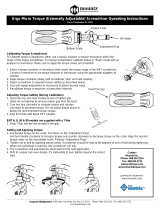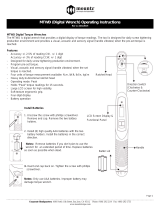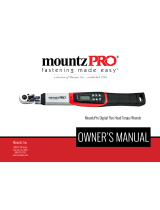Page is loading ...

Operating the Tool
1. Select a bit. Retract the bit collar. Insert the bit and release the retracted collar. To avoid
damaging fasteners, make sure the proper bit is suitable for the head of the fastener.
2. Rotate the torque adjustment nut to set the torque limit. Turn clockwise to increase torque
and counter clockwise to decrease torque.The scale adjacent to the Torque Adjustment
Nut is a reference guide. The torque output from the driver can change depending on
various fastening factors like friction, type of joint, and the type material being used like a
washer.
3. Make sure the FOR/STOP/REV switch is in the “Stop” position. Connect power cord.
4. Turn driver on and check for proper rotation. FOR-clockwise, REV-counterclockwise.
5. To apply torque, squeeze the lever (Push-to-Start models - place light downward pressure
on the nose of the driver). The driver will automatically stop when the preset torque has
been reached. Never run the motor continuously for extended periods. Use tool
intermittently: (example 5 seconds on and 3.5 seconds off).
6. To remove the screw, turn the FOR/REV switch to REV.
Testing Power Tools:
1. Application Method: Use a torque analyzer in “Peak Mode” with a
rotary transducer between the power tool and the actual application.
This is the best way to test since you are using the actual joint
as the test station. You will see the actual torque
applied to the fastener. Caution: Variances in tool
performance may occur do to the addition of the
rotary transducer.
2. Simulated Method: Always use a quality
joint rate simulator (run down adapter)
with a torque analyzer when testing
power tools in a simulated application.
Use Joint rate and Breakaway methods to obtain
most accurate torque readings in a simulated
rundown.
CARE
1. The screwdrivers are a precision torque control
instrument and should be handled with care at all
times.
2. Operate under safe conditions. Do not place in
operation where such objects as hair, strings,
clothing, etc. can become tangled in the rotating bit.
3. Keep away from moisture. Never use in high
humid, moist or damp environment.
4. Never change the direction of the rotation when
the tool is in use.
5. Never run the motor continuously for extended
periods.
6. Never lubricate electrical parts.
7. Check carbon brushes periodically.
8. Avoid continuous cycling over short periods.
9. It is recommended not to use the tool for fastening
applications with long rundown times.
10. Never use the power cord for hanging the tool (use
hanger for it) and don’t carry the tool by the cord.
Power Cord
Hanger
Carbon Brush
Caps
Ventilation
Holes
Lever (Push-to-
Start models do
not have Lever
Torque Adjustment
Nut
Bit collar: Push the bit
collar up and insert
bit.
Scale
Reference
Ventilation
Holes
Rotate the torque adjustment nut:
Clockwise to increase torque
Counterclockwise to decrease torque
Corporate Headquarters: 1080 North 11th Street, San Jose, CA 95112 Phone: (408) 292-2214 Fax: (408) 292-2733
www.mountztorque.com
E-D IV® E-Series E201,251,301 & 301-HT Operating Instructions
Rev 2.0 (January 16, 2012)
R

Corporate Headquarters: 1080 North 11th Street, San Jose, CA 95112 Phone: (408) 292-2214 Fax: (408) 292-2733
www.mountztorque.com
Torque Reference Charts
These charts are meant to be used as guidelines for setting the torque on the E-Series electric screwdrivers. The drivers
have a torque scale on the torque adjustment nut showing reference numbers. These numbers determine the approximate
torque setting. Refer to the charts to determine the reference number setting for your torque requirement.Torque ranges
(lbf.in) approximate tightening torque. Figures below each chart indicate scale setting on the tool.
Color of Springs: S = Silver B = Blue K = Black Y = Yellow
6
5
4
3
2
1
lbf.in
Torque Scale
E201
Y
Torque Range
0.8-4.8 lbf.in
E251
1 2 3 4 5 6
Torque Scale
2
4
6
8
10
12
14
16
lbf.in
7 8
B
Torque Range
1.7 - 10 lbf.in
1 2 3 4 5 6 7 8
E301
1 2 3 4 5 6
Torque Scale
2
6
8
10
12
14
16
lbf.in
7 8
18
20
22
S
Torque Range
3.4-15.7 lbf.in
E301-HT
1 2 3 4 5 6
Torque Scale
2
4
6
8
10
12
14
16
lbf.in
7 8
18
20
22
K
Torque Range
6.9-26 lbf.in
24
26
E-D IV® E-Series E201,251,301 & 301-HT Operating Instructions
Rev 2.0 (January 16, 2012)
R

Corporate Headquarters: 1080 North 11th Street, San Jose, CA 95112 Phone: (408) 292-2214 Fax: (408) 292-2733
www.mountztorque.com
E-D IV® E-Series E201,251,301 & 301-HT Operating Instructions
Rev 2.0 (January 16, 2012)
R
Mountz Service Locations
Eastern Service Center
19051 Underwood Rd.
Foley, AL 36535
Phone: (251) 943-4125
Fax: (251) 943-4979
Western Service Center
1080 N.11th Street
San Jose, CA 95112
Phone: (408) 292-2214
Fax: (408) 292-2733
Mexico Service Center
Mountz Mexico SA de CV Chihuahua
Av. Cristobal Colon #15343
Col. Paseos de Chihuahua
Chihuahua, Chih. Mexico CP 31125
Phone: (614) 481-0023
Fax: (614) 481-0053
www.mountztorque.com
Download a “Service Form” and include a copy
when you send the tools in to be serviced.
Looking for fasteners?
www.mrmetric.com
Replacing carbon brush:
Carbon Brush
Brush Cap
1. Disconnect the power cord prior to replacing the carbon brushes.
2. Remove brush caps and replace the worn carbon brushes as needed.
3. Install brush caps and run the tool approximately one minute before use.
limit margin for using 4mm
Trouble Trouble Shooting
The motor never runs. 1. Check power cord and carbon brush.
The motor doesn’t run 1. Check the abraded carbon brush and
sometimes. replace it.
2. Check the connection contact of
power cable and cord.
Mountz Calibration & Repair Services
Mountz Inc. features an experienced calibration and repair staff.
Our trained technicians can calibrate and repair most any tool.
Mountz provides rapid service with quality that you can trust as we
offer three state-of-the-art calibration lab and repair facilities that
can calibrate up to 20,000 lbf.ft.
With over 45 years of experience, Mountz’s in-depth knowledge of
torque is reflected in our tool’s craftsmanship and our ability to pro-
vide solutions to both common and uncommon torque applica-
tions. We perform calibrations in accordance with ANSI/NCSL-
Z540. Mountz is dedicated solely to the manufacturing, marketing
and servicing of high quality torque tools.
Mountz is an ISO 9001 certified and ISO 17025 accredited compa-
ny.
Tool Service & Repair Capability
Torque Wrenches: Click, Dial, Beam, Cam-Over & Break-Over
Torque Screwdrivers: Dial, Micrometer, Preset & Adjustable
Torque Analyzers/Sensors: All brands
Electric Screwdrivers: All brands
Air Tools: All brands
Impact Wrenches, Drills, Pulse Tools, Grinders, Percussive Tools,
Air Screwdrivers, Nutrunners, DC Controlled Nutrunners
Torque Multipliers: All brands
/












